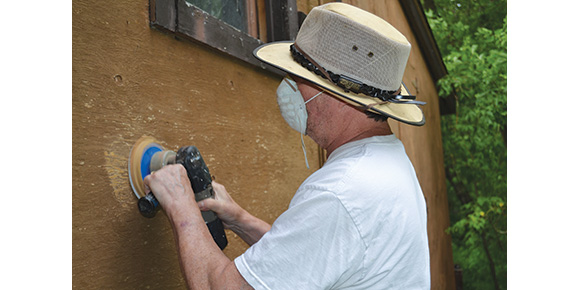Our family cottage has high-gloss alkyd paint on the exterior walls and trim. We have decided to repaint the outside with semi-gloss acrylic because the water-based paint is easy to clean up and manufacturers claim new formulations now outperform oil-based products.
As a die-hard believer in oil paint, I spent time investigating the new exterior acrylic products. For one thing, I had been told that acrylics will not stick to alkyds. This used to be true until paint chemists created an oil-based primer that bonds with water-based acrylics. The primer costs about $40 a gallon and is brushed or rolled over an alkyd covered surface.
A high- or semi-gloss alkyd must be scuff-sanded and then cleaned with a hose or pressure washer to remove dust and debris. A single coat of primer followed by two coats of acrylic is recommended. I found Warren Mark of Park City Paints to be particularly knowledgeable on this subject.
Painting, especially with oil-based products that require varsol, paint thinner or turpentine to clean up, can be a messy affair. One tip I have learned about working with paints is to prevent overloading your brush by dipping the tip into the paint and wiping one side of the brush on the side of the can before applying the product. Also, only use the tip as the applicator as brushing with the side will damage the bristles and result in paint being sprayed on to unwanted surfaces.
Another tip is to purchase masking tape from auto refinishers if you are painting coping or other trims close to window panes. Auto-grade masking does not allow paint to bleed behind the edge of the tape and is easier to adhere and remove than so-called painter’s tape, sold at big box stores.
And while you are in the auto refinishing store, consider purchasing a box of 80-grit sanding discs. They fit a standard six-inch diameter random orbit machine, are of better quality and, if purchased in bulk, cheaper than those sold in hardware outlets. A box of 50 Basecut discs costs about $40.
If you are closing a can of half-used paint, clean out the rim crevice and place an old cloth over the lid before hammering it lightly into position. This simple trick prevents spray back from any paint remaining inside the rim. The paint’s lifetime can be extended by drooping plastic household wrap inside the can, forcing out excess air that causes stored paint to set prematurely.
For people like myself, who never seem to clean equipment properly, there is a tool that uses centrifugal force to remove paint from rollers and brushes. This inexpensive, useful device looks like a bicycle pump. It is equipped with a plunger that is pumped up and down, causing a brush and roller holder at the opposite end of the barrel to spin rapidly, forcing solvents and paints to spray outward, away from the brush or roller. It’s best to operate this device inside a five gallon pail to prevent splattering yourself with the residue. Big-box and paint stores sell them for about $10 to $15 each, depending on quality.
Soaking brushes in tri sodium phosphate (TSP) is an old cure for reclaiming brushes that some negligent person (mea culpa) has neglected to clean properly. It’s still available at any paint retailer and it does work.
Caveat: Do not soak the brushes for more than eight hours in a mixture of one part TSP to 10 parts warm water, otherwise they will fall apart, I know. (If you are not a fan of sanding, a TSP solution will clean and prepare an old painted surface to receive a new coat of primer.)
Speaking of brushes, I’m a sucker for the $9.99 four-pack of cheapies. Despite knowing better, I buy them and spend more time picking the bristles out of the paint than applying it. I’m trying to rid myself of this Scrooge-like habit by purchasing better quality brushes that cost $10 or more apiece and taking better care of them.
Rollers are another matter. When varsol or paint thinner was selling for about $4 to $5 a gallon, it was worth cleaning alkyd paint from a good roller. However, at today’s price for thinners — up to $19 for a gallon of varsol — it is less expensive to buy five-packs of cheap rollers and throw them away after one use. This is frowned upon by “greenies,” as it should be.
That’s why acrylic paints were invented: Using eco-friendly, abundant water and a centrifuge, a painter can afford to purchase, clean and reuse quality brushes and rollers many times over.
In the next column, I will discuss the pros and cons of using air equipment to sand, caulk and paint the exterior of a house or cottage.



